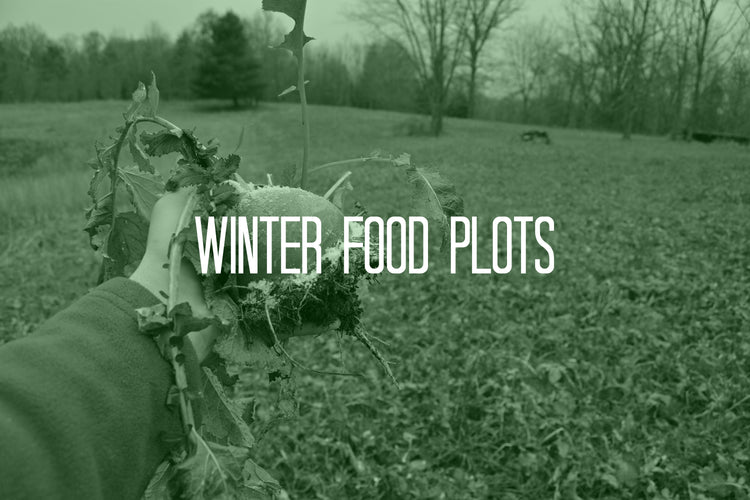What Does a Deer Eat During the Late Season/Winter?
By: Weston Schrank
As the rut transitions into the post rut and the procession from the post rut into the late season blurs, hunters are often left with only one hunting strategy. When the temperature plummets head to the food…It is in this transition period and for the next two months that most hunters either count their blessings for putting the time in on food plots or feel horrible regret once their bucks exit their property for the neighbor’s buffet. If it’s the latter, then your worst fears of your hit-list buck draped over a tailgate in a text from your neighbor will become very real. Late season and winter hunting strategies outright depend upon food…tons and tons of food. Fortunately, I have some advice for both sets of hunters, the prepared and unprepared, and some tips for your future winter food plots!
5 Of the Best Winter Food Plots
First to cover what most of you came for… the list of the 5 best winter food plots. While this is not a bulletproof list, these are common species that happen to work well for the properties I hunt in the Midwest. If you’re already behind or don’t think the list applies to your property please skip to the end and see some extremely common sense and helpful tips!
Soybean Food Plots
I absolutely love soybeans, they are hard to beat for a whitetail forage and late-season food source. How can you argue against a food plot species that provides protein all summer long and during late spring that suddenly turns into a food source that can provide grain even with a foot of snow on the ground? Not to mention the fact that you can establish and maintain them with some basic equipment. Like I said, hard to beat!
However, there are several things that you should take into consideration before planting beans. These include the size of the plot, your budget, other food sources on or near your property, and of course the soil. The first and biggest consideration is the size of the food plot. If you have a 1-acre food plot, you have to ask yourself is it even worth planting a 1-acre plot? You’ll put time and money into a plot of stubble, the deer will simply mow it down. At least they will unless you get creative… https://www.youtube.com/watch?v=f3FXkO4AhMk As a general rule of thumb without knowing deer density, 3-5 acres is the minimum acreage you need to actually make it to grain. If you have that, then you can advance into food plot soil preparation and consider some of the mixes/tips below. If you’re dealing with less acreage, then it may be time to get creative with a dual perimeter electric food plot fence. This is one of the best ways to keep a deer out of a food plot. It will allow the soybeans to make it to grain, exclusively for your late-season hunting strategy. Check out the full blog on this setup, as well as hunting considerations: Small Soybean Food Plots 101
Corn Food Plots
The other giant to mention for winter food plots is corn. While it doesn’t have the pull soybeans do for the rest of the year, it’s hard to argue with the fat and carb content that corn provides, and the deer know and exploit that. A standing corn field knocked down just before or after a snow storm can pull your entire deer herd and the neighbors into the field! If you have the acreage, the equipment, and the budget to buy the seed, herbicides, food plot lime, and the required fertilizer then go for it! However, you might want to weigh the options of what you could be using that available food plot real estate for. https://www.youtube.com/watch?v=To14TZjAk9Q Don’t get me wrong, corn is a powerful plot, but I like plotters and hunters to understand the potential for every acre of the plot. Check out the debate here: Corn Versus Soybean Food Plots. Corn has a lot of energy… while it might only have 2-4% fat, it’s around 75% carbohydrates. Beans, on the other hand, have more protein, but also provide around 20% fat. Having both side by side could be a huge draw from a winter food plot’s perspective. But again…only if you have the acreage.
Brassica Food Plots
Brassicas are all the rage, but at least on my properties, I can’t get the deer to eat them…even after 4 years. It seems to be hit or miss for most DeerGro customers as well. Brassicas have that great ability to switch on at just the right time of year. Right when hunting starts getting hot, and it’s a good time to key in on areas with high doe densities frost hits…That means brassicas send sugars up, ringing the dinner bell to your property’s deer. If they get accustomed to them, they can quickly tear up the brassicas. That’s inevitably the downfall though. While they provide a ton of leafy forage, small plots can be consumed quickly and all activity fades afterward. For this reason, if I’m doing a brassica plot, I’m doing a mix with winter wheat or rye. This means there is something in the ground that I can count on to keep the deer around after the deer wipe the brassicas out. If you are looking to plant turnips and rape for deer, understand that they require the soil and nutrients to be just right, something that you may have to amend with high-dollar fertilizer. Be prepared to give them this dedication or you’ll have a pretty sad plot that is put simply, a lot of wasted space.
Winter Wheat, Oats, and Rye Food Plots
These are all great fall/winter food plot species, as stand-alone, fillers, or even additions to other food plots. Oats are heavily targeted by deer, but fail to stand up to the winter like wheat and rye, and while rye is the least attractive of the three it pulls its weight with establishment and plot soil health benefits. Winter wheat and rye can be a go-to panicked and rushed food plot strategy. It also can be a huge advantage for hunters without a lot of food plot space, in an area of big agriculture. Simply talk the farmer into doing cover crops, or get his blessing to plant about 3-5 acres of his field, broadcasted just before beans are harvested or just after corn is. They can be established in poor soils, late into the year, and can mine nutrients out of the soil. Read a full write-up on rye here: Fall Food Plots and Rye. These species pair up extremely well with several mixes, including clovers, and can even be worked into more attractive food plot systems.
Winter Food Plot Mixes and Systems
Mixes are a great way to use certain food plot species' strengths with other strengths or weaknesses provided by another species. A great example is wheat and ladino white clover. While clover fixes nitrogen and provides a lush green carpet of nearly indestructible forage, wheat nurses it, allowing it to grow without being browsed too heavily during its early stages. Wheat, oats, and rye go great with brassicas and clovers, but there is one mixture or rather “food plot system” that I really love.
Right during the period when Soybeans turn yellow and drop their leaves, I broadcast either 50/50 winter wheat and rye, or a combination of wheat, oats, and rye overtop the beans. Considering there is weed control, the seeds will make it to the soil before the leaves, and once the first rain hits will germinate before the sunlight sparks weed growth. This creates a food plot that supplies standing grain, with a continuously growing green forage. Even after the pods are long gone, deer will still demolish the wheat and rye. Once spring arrives the food plot mix will mine the nutrients back over, and provide a very effective weed control mat.
Planting Method and Food Plot Soil Preparation
Plot preparation is pretty cut and dry, and I’ll leave it up to another blog to explain the details: Food Plot Prep. However, I will use a phrase you’re not unfamiliar with…do a soil test! I can’t tell you how many times I have seen a plot go in with time and money spent, with a food plot with inch-long brassicas, wheat, or bean sprouts that are yellow. Know your food plot pH, nutrients, and potential then apply the right amount of food plot fertilizers and lime.
Winter Hunting Tip | What Do Deer Eat During the Late Season?
Whether you have winter food plots or you don’t, there is one tactic that can quickly help you identify your deer herd’s late-season forage…opening their stomach! Now I know most of you aren’t afraid of a little doe management, that is unless it might cause an interruption in your late-season quest for your hit-list buck, however, if you’re questioning the deer herd’s food sources, or where does are spending time at to locate a buck, I suggest doing the following… https://www.youtube.com/watch?v=DQP-gcJRIMA While it might go against your programming of not cutting the stomach during the gutting process, Slicing it open can reveal some very critical info. If you have rye on the property as I did, and the stomach confirms it, then chances are you’ll hunt that portion of the property and see your buck. If however, you notice woody browse or acorns, well then you might have to start looking to the woods and the terrain for help in finding your buck.


